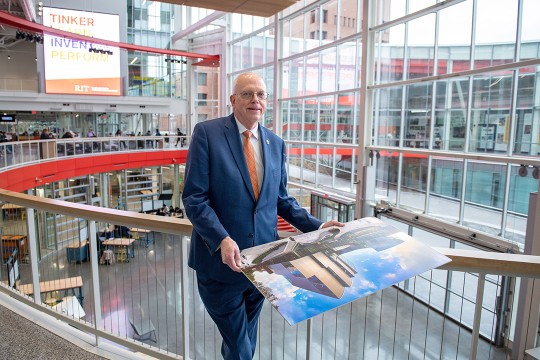How do Images of War and Disaster Shape Social Change?
RIT Conference Explores the Power of Visual Communication
April 3-6 event draws scholars from across the country
The power of pictures to influence attitudes and social change—to galvanize opinions for or against certain issues—seems especially prevalent during times of uncertainty and impending war.
Understanding images of war and disaster will be part of a broader, three-day conference April 3-6. Visual Communication and Social Change: Rhetorics and Technologies offers free, public panels and presentations sponsored by Rochester Institute of Technology’s College of Liberal Arts’ William A. Kern Endowment in Communication. The conference will be held at the Strathallen hotel at 550 East Ave. with featured presentations and exhibits on the RIT campus and at RIT’s Gallery r at 775 Park Ave.
"This conference examines the rhetoric of visual images and also the visual technologies that work to change society. Often they work hand in hand," says Diane Hope, Kern Professor in Communications at RIT and organizer of this biannual event. During the last decade, visual communication emerged as a serious field of study that crosses and connects disciplines. RIT’s conference reflects this interdisciplinary appeal by drawing a range of scholars, including renowned research scientist Felice Frankel from Massachusetts Institute of Technology and designer Mary Stieglitz from Iowa State University, to explore visual communication issues involving photojournalism, public art, science, maps and geographic information systems, design and labor movements.
The conference will begin at 9 a.m. on April 3 with Hope’s welcome and opening address, "Social Change and the Intersections of Rhetoric and Technology in Visual Communication."
Other highlights (at Strathallen) will include the talks:
- St. George and His Followers Prepare for Battle, by Sally Gill, Alliant International University
- Moses vs. Moore: Free Speech and Gun Control in Winning the Cultural War and Bowling for Columbine, Brian Snee, Bellarmine University
- AMBER Alert: The Subject Citizen and Technologies in Transformation, Julie Borkin, Wayne State University
- Optical Allusions: Rhetoric as Technology and the Question of Attention in ‘The 9/11 Mystery Rash’ by William Trapani, Wayne State University
- Bread and Roses: Visual Analyses and Representations of Labor Movements, David Neumann, RIT
- Intersecting Circles: Neighbors, Neighborhoods, Communities, by Loret Gnivecki Steinberg, RIT; photographs by RIT’s photojournalism students at Gallery r
- Ritualizing Modernity’s Gamble: Representing Disaster in the Iconic Photograph of the Explosion of the Challenger, John Lucaites, Indiana University, and Robert Hariman, Drake University
- The Visual Communication of Gordon Parks: A Rhetorical Analysis of Half Past Autumn, Keith Jenkins, RIT
Presentations at RIT will include:
- A tour and introduction to the RIT poster archives in RIT’s Archives and Special Collections, led by Kari Horowitz, librarian and archivist
- Rural Electrification Administration: A Rhetorical Analysis of the Lester Beall Posters (1937-1941) from the RIT archives, by Sue Barnes, professor of communication at RIT
The William A. Kern Professorship in communications was established as an endowment by the Rochester Telephone Co. to commemorate the company’s 100th anniversary and to memorialize a former company president and RIT trustee.
The endowment provides instruction and research into contemporary communications issues. The Kern Professorship resides in RIT’s Department of Communication within the College of Liberal Arts.














